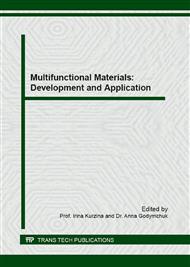[1]
A. Hamilton, P. Hamilton, Plant conservation: an ecosystem approach, Earthscan, London, (2006).
Google Scholar
[2]
T. Tickin, Ecological applications of harvesting non-timber forest products, J. Appl. Ecol. 41 (2004) 11-21.
Google Scholar
[3]
T. Andel, R. Havinga, Sustainability aspects of commercial medicinal plant harvesting in Suriname, Forest Ecol. Manag. 256 (2008) 1540-1545.
DOI: 10.1016/j.foreco.2008.06.031
Google Scholar
[4]
U. Schippmann, D. Leaman, A. Cunningham Impact of Cultivation and Gathering of Medicinal Plants on Biodiversity: Global Trends and Issues, FAO, Rome, 2002, Available at: http: /www. fao. org/docrep/005/aa010e/aa010e00.
Google Scholar
[5]
A.C. Hamilton, Medicinal plants, conservation and livelihoods, Bioders. Conserv., 13 (2004) 1477-1517.
Google Scholar
[6]
N.A. Nekratova, N.F. Nekratov, Medicinal herbs of Altai-Sayan mountain area, Tomsk State University Ed., Tomsk [in Russian], (2005).
Google Scholar
[7]
C.M. Peters, The Ecology and Management of Non-timber Forest Resources, World Bank Technical Papers, Washington, (1996).
Google Scholar
[8]
A. Polozhij, B. Postnikov, Y. Surov, Maral root, in: A. Tolmachev, A. Schreter (Eds. ), Atlas of geographical ranges and resources of medicnal plants of the USSR, Main Office of Geodesy and Cartography, Moscow [in Russian], 1976, p.263.
Google Scholar
[9]
V. Syrov, A. Kurmukov, On anabolic activity of phytoecdizone ecdisterone isolated from Rhaponticum carthamoides (Willd. ) Iljin, Pharmacol. Toxicol. 39 (1976) 690-693.
Google Scholar
[10]
I. Todorov, Y. Mitrokhin, O. Efremova, L. Sidorenko, The effect of ecdysterone on the biosynthesis of proteins and nucleic acids in mice, Pharm. Chem. J-USSR, 34 (2000) 455-458.
Google Scholar
[11]
E. Gol'dberg, E. Amosova, E. Zueva, T. Razina, S. Krylova, Effects of Extracts from Medicinal Plants on the Development of Metastatic Process, B. Exp. Biol. Med. 138 (2004) 288-294.
DOI: 10.1007/s10517-005-0023-x
Google Scholar
[12]
M. Plotnikov, O. Aliev, A. Vasil'ev, V. Andreeva, E. Krasnov, Effect of Rhaponticum carthamoides extract on structural and metabolic parameters of erythrocytes in rats with cerebral ischemia, B. Exp. Biol. Med., 146 (2008) 45-48.
DOI: 10.1007/s10517-008-0202-7
Google Scholar
[13]
L. Kokoska, D. Janovska, Chemistry and pharmacology of Rhaponticum carthamoides: A review, Phytochemistry, 70 (2009) 842-855.
DOI: 10.1016/j.phytochem.2009.04.008
Google Scholar
[14]
S.S. Azimova (Ed. ), Natural Compounds – Phytoecdysteroids, Springer Science, Business Media New York, New York, (2013).
Google Scholar
[15]
M. Dushkin, M. Khrapova, G. Kovshik, M. Chasovskikh, E. Menshchikova, V. Trufakin, A. Shurlygina, E. Vereschagin, Effects of Rhaponticum carthamoides versus Glycyrrhiza glabra and Punica granatum extracts on metabolic syndrome signs in rats, BMC Complet. Alt. M. 2014, Available at: http: /www. biomedcentral. com/1472-6882/14/33.
DOI: 10.1186/1472-6882-14-33
Google Scholar
[16]
N.A. Nekratova, M.N. Shurupova, Resources of medicinal plants in the Kuznetsky Alatau, Int. J. Environ. Stud. 71 (2014) 656–666.
DOI: 10.1080/00207233.2014.944790
Google Scholar
[17]
J. Sheldon, M. Balick, S. Laird, Medicinal plants: can utilization and conservation coexist, New York Botanical Garden Press, New York, (1997).
Google Scholar
[18]
M. Sampaio, I. Schmidt, I.B. Figueiredo, Harvesting Effects and Population Ecology of the Buriti Palm (Mauritia flexuosa) L. f., Arecaceae) in the Jalapao Region, Central Brazil, Econ. Bot. 62 (2008) 171-181.
DOI: 10.1007/s12231-008-9017-8
Google Scholar
[19]
H. Moyo, M.C. Scholes, W. Twine, The effects of repeated cutting on coppice response of Terminalia sericea, Trees. 29 (2015) 161-169.
DOI: 10.1007/s00468-014-1100-4
Google Scholar
[20]
J.H. Rock, B. Beckage, L.J. Gross, Population recovery following differential harvesting of Allium tricoccum Ait. in the southern Appalachians, Biol. Cons. 116 (2004), 227-234.
DOI: 10.1016/s0006-3207(03)00193-9
Google Scholar
[21]
L.M. Castle, S. Leopold, R. Craft, K. Kindscher, Ranking Tool Created for Medicinal plants at Risk of Being Overharvested in the Wild., Ethnobiol. Let. 5 (2014), 77-88.
DOI: 10.14237/ebl.5.2014.169
Google Scholar
[22]
A. Kuminova, Vegetation of Altai, Nauka Publ., Novosibirsk [in Russian], (1960).
Google Scholar
[23]
V. Sedelnikov, High-mountain vegetation of the Altai-Sayan Mountain Area, Nauka Publ., Novosibirsk [in Russian], (1988).
Google Scholar
[24]
I. Smelansky, G. Kamalutdinov, M. Roshkanyuk, A. Barashkova, E. Korolyuk, Trade in Wild Medicinal and Aromatic Plants in Russian Sector of Altai-Sayan Eco-region: Conservation Aspects. Report, WWF, Novosibirsk, (2009).
Google Scholar


